Gransfors Small Forest Axe vs Hults Bruk / Hultafors
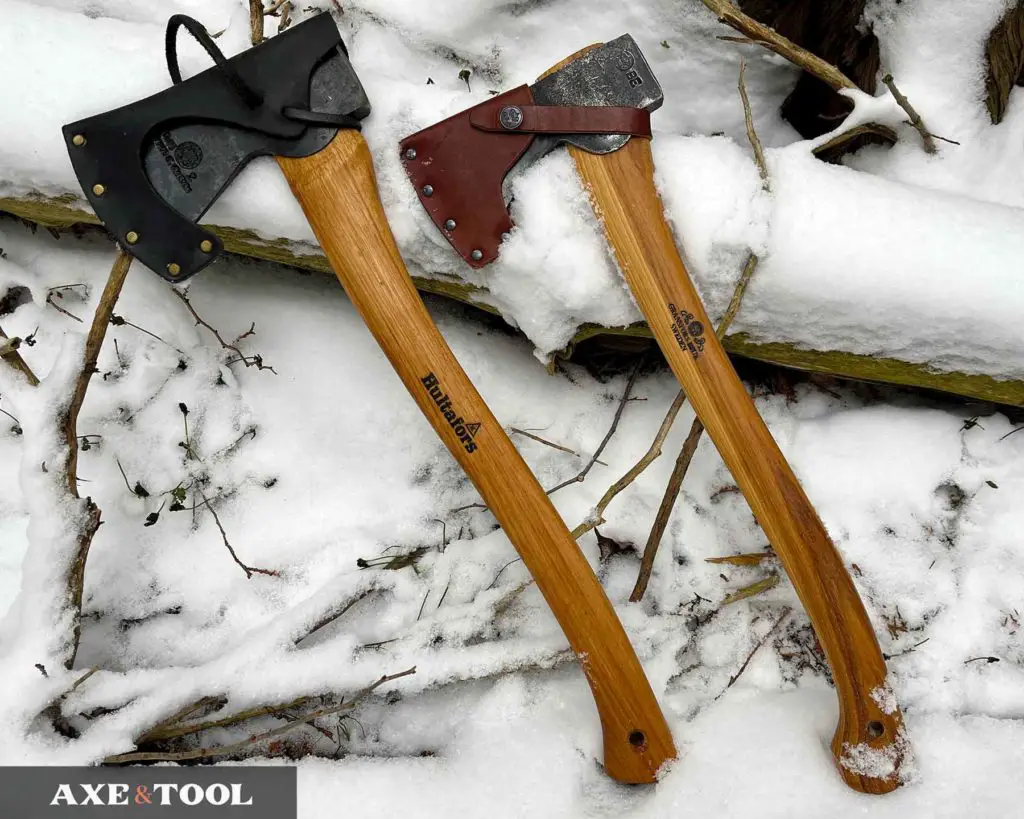
I didn’t need both of these axes. But it had to be done for research… yeah that’s it. And in short – they are both excellent, but they have slightly different strengths.
The Gransfors Bruk Small Forest Axe and Hults Bruk Aneby (Hultafors Ekelund) are very similar premium axes that can be used one or two-handed for chopping, limbing, and bushcraft tasks. The Gransfors is lighter and more nimble at one-handed tasks while the Hults offers more power in two-handed use.
Note: The Hults Bruk Aneby and Hultafors Ekelund are the same axe. Hultafors owns Hults Bruk and these axes are just sold under different names in different locations (see more here).
With most outdoor tools you are forced to balance capability and mobility (weight, size). This is how you should make your choice between the two axes.
I will run through the features, designs, and performance of these two axes to help you pick.
| Small Forest Axe (Gransfors Bruk) | Aneby / Ekelund (Hults Bruk / Hultafors) | |
|---|---|---|
| Length | 19″ (48.5mm) | 20″ (51mm) |
| Head Weight | 1.65lb (0.75kg) | 2lb (0.9kg) |
| Total Weight* | 2.16lb (0.985kg) | 2.58lb (1.175kg) |
| Cutting Edge | 3.25″ (83mm) | 3.3″ (84mm) |
| Bevel Angle | 30° | 30° |
| Sheath | Light leather, snap button | Heavy leather, drawstring |
| Special | Factory waxed handle | Smooth pole for hunters |
Even with premium axes, it’s best to buy in person if possible, but sometimes it’s not an option. I ordered both of these axes (and others from the same makers) online, and the quality control from both companies seems good, so you can buy with more confidence than the cheaper brands.
If you end up ordering from amazon, please help us out and use the links below – thanks!
Gransfors Bruks Small Forest
Hults Bruk Aneby (US)
Hultafors Ekelund
Both axes have “forest axe” head designs
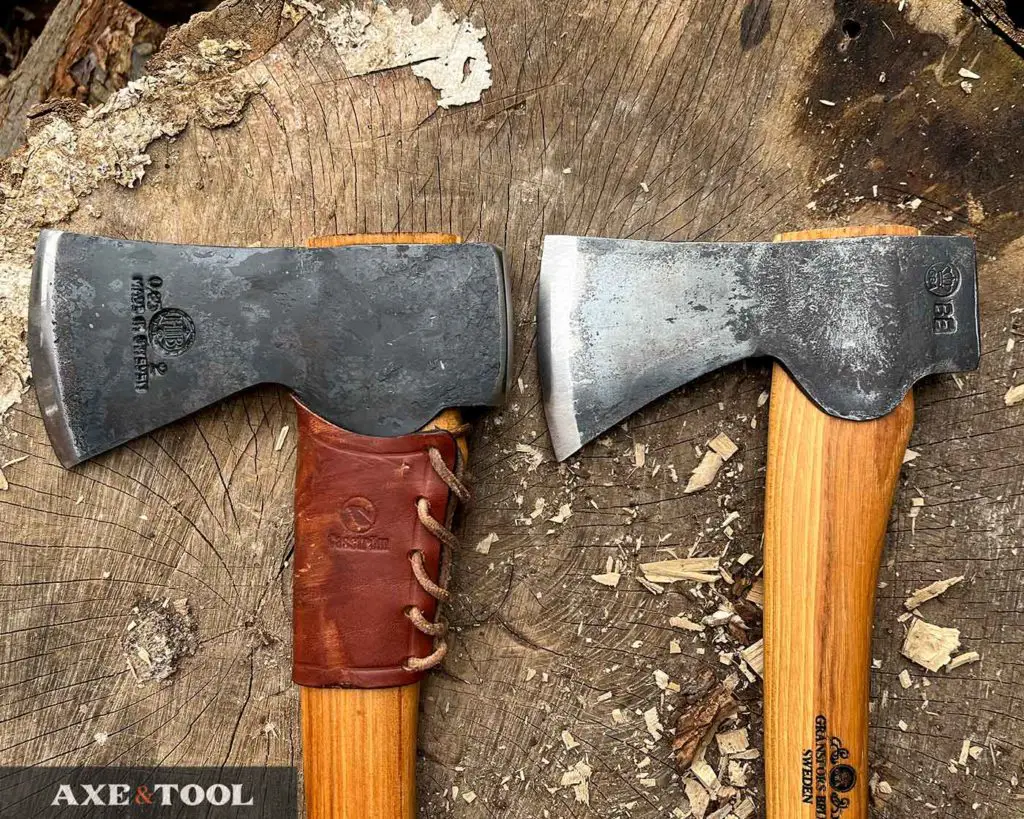
Both these axes have narrow felling heads with thin blades and a finger groove on the bottom. These “forest axe” patterns are versatile in the wilderness and can be used for chopping, limbing, light splitting, and carving.
The Hults Bruk is a little longer, and heaver at 2lbs and designates their axes as a Turpentine pattern.
The Gransfors is about 1.65lbs (they don’t list the exact weight). The Gransfors design is similar to the HB but unique and and doesn’t have a listed name.
The cutting edges are basically the same length, but there is a bit of a difference in the curve and angle, which I will describe more in the chopping comparison.
They are both very hard Swedish steel and come sharp.
Both axes come sharp
Both axes are hand-sharpened at the factory at a 30° bevel and come ready to use. I would say that they are even in sharpness and detail. You can get them sharper yourself, but they are quite good.
Hults Bruk polishes the edge, which is nice but doesn’t add much in terms of function.
Forge finished heads
Both axes have a very appealing forge finish.
The Aneby/Ekelund has a deeper bluish/black, that often has some red undertones. It’s quite durable, and I think it’s the best-looking finish of any axe I own (totally a matter of opinion).
The Small Forest Axe is more of a flat grey, with a little more shiny steel showing at the high points where the finish has worn off. It also looks great.
Gransfors also stamp the initials of the smith into each axe head, which adds a bit of “cool factor”.
The Aneby is a Hunter’s Axe
The pole (back of the axe head) of the Aneby is ground smooth, slightly rounded with bevels at the edges. This lets it be used for skinning by hunters.
The Small Forest Axe just has a normal pole, but they offer a similar-sized Hunter’s axe as well.
Handle differences between Gransfors and Hults Bruk
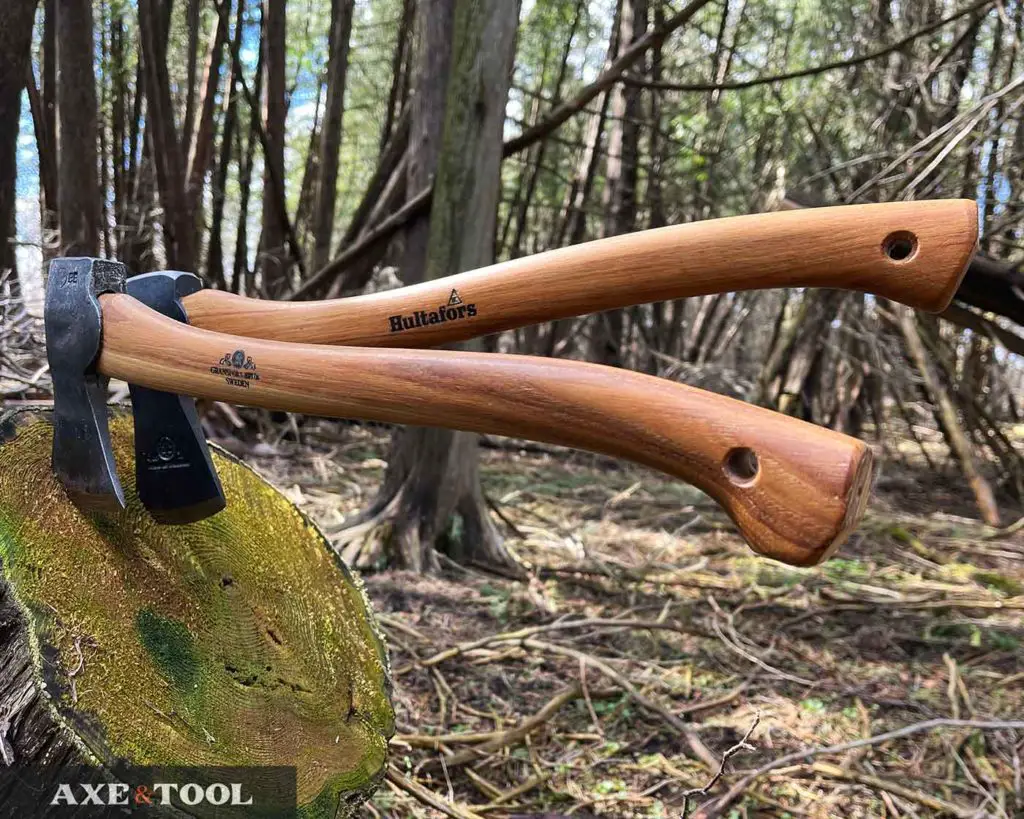
These handles are close in size, but they feel a bit different in hand.
Both handles are 23mm (0.9″) wide, which is a little thick for a felling axe, but is okay for a bushcraft axe. The extra strength can be useful for prying.
The Small Forest Axe 19″ handle is a unique teardrop shape, pointed at the front and rounded at the back. This feels a little more locked in during one-handed use. The shoulder is also a smaller and fits in your hand better when you are choked up right under the head.
But the downside of the teardrop shape is that it feels a little “round” when used two-handed.
The Aneby/Ekelund 20″ handle is a traditional axe oval shape, that feels very natural when being used two-handed. But it doesn’t lock in quite as tight at the web of your thumb when used one-handed. That is also exaggerated a little by the heavier head.
Note: These are “nit-picky” details and both axes can easily and confidently be used one or two-handed. They just help add to the overall picture.
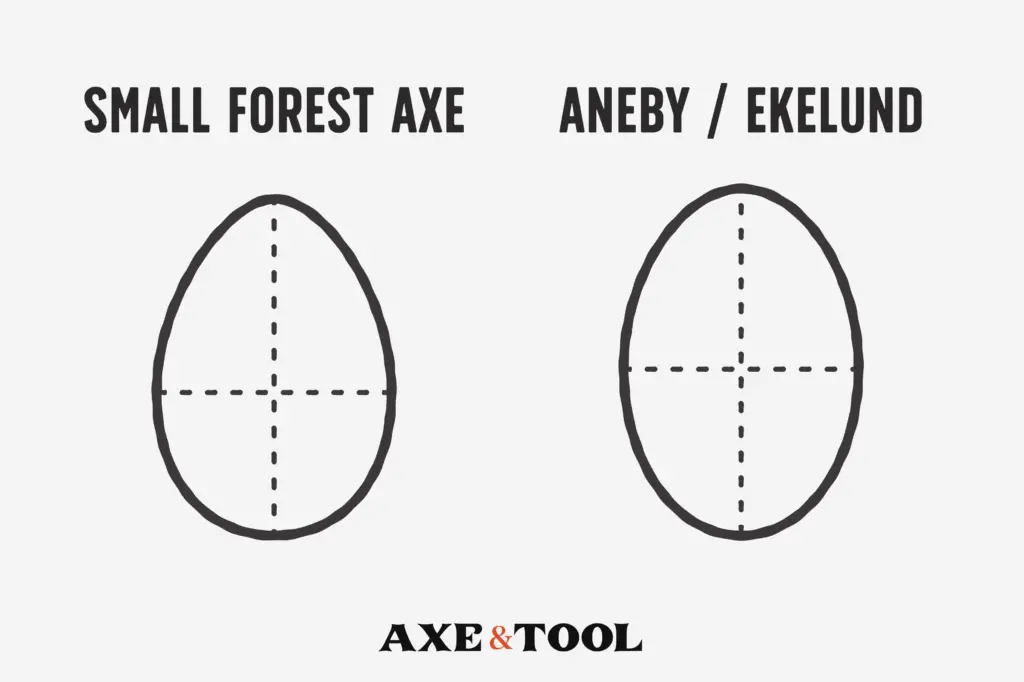
Gransfors Bruk waxes their handles
While both these premium handles come shaped and oiled but there is a noticeable difference in finish.
The Gransfors Bruk handles have been tumbled in wax at the factory after they are oiled. This means they come feeling quite smooth in hand.
The Hults Bruk / Hultafors handles are oiled, but all of mine have come with a coarser surface finish. You can feel a bit more of the grain in hand. I think this is intentional, as some people like a little more texture for grip – and it’s easier to smooth a handle than add texture to it.
I like smooth handles so I used 100 and 220 grit sandpaper on my Aneby/Ekelund and re-finished it with boiled linseed oil. See my step-by-step finishing process on this exact axe.
Different approaches to hanging the axe
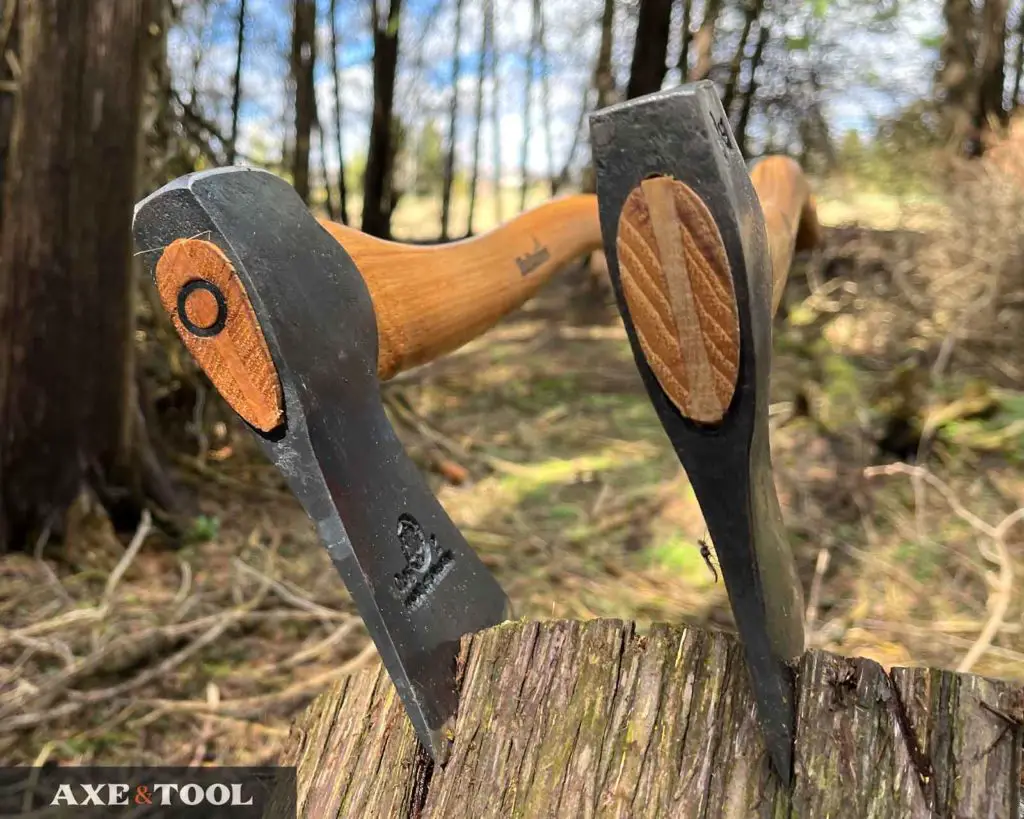
Both axes are hung tight and fit well. I believe they are both fit by hand, so this should be expected.
The only difference worth noting is that Hults Bruk adds a metal wedge to tighten the axe head as much as possible and reduce the chance of loosening. Almost all axe makers today do this.
However, Gransfors does not add a wedge. I prefer this because it is the more traditional approach, and shows the confidence they have in their hangs. But more importantly, it’s also much easier for you to add a wedge yourself if the head does loosen with time.
If an already wedged axe does loosen, it’s hard to add another one and more likely to require a rehang (not that the Hults is likely to loosen).
Gransfors Bruk vs Hults Bruk sheaths
Both axes come with good sheaths (masks), made with nice leather and a full welt. But they again take different approaches.
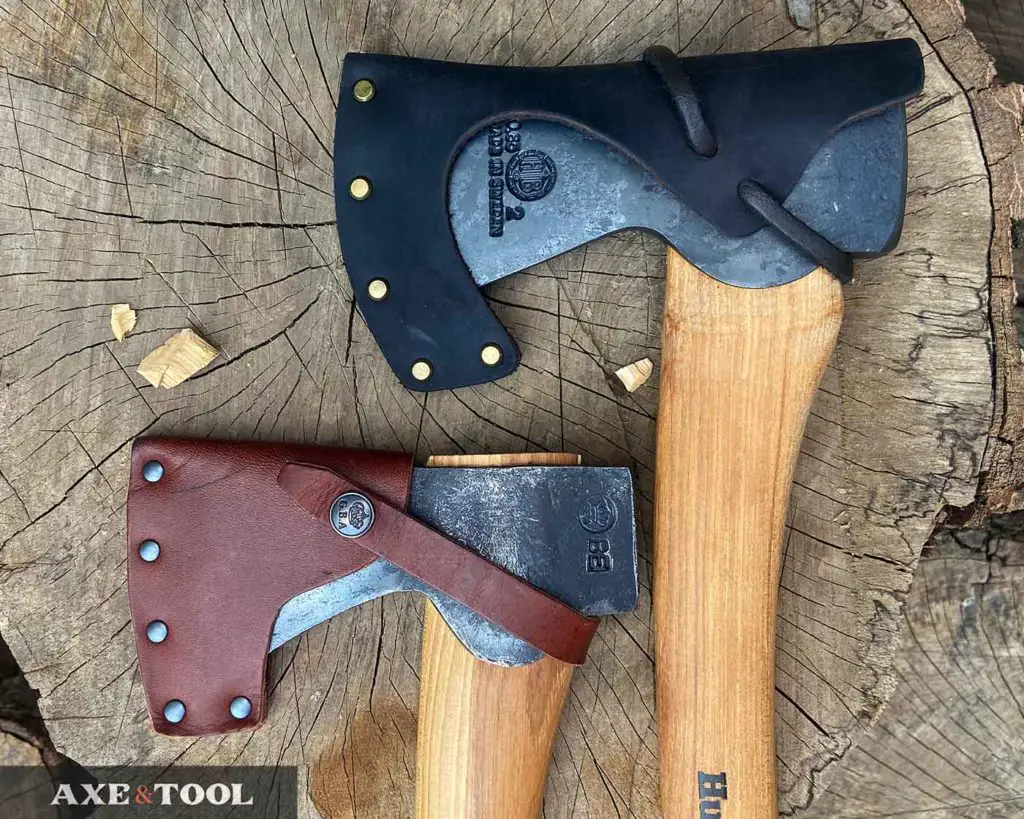
The Gransfors sheath is lighter (thinner) leather and only partially covers the head. It’s secured with a snap, which makes it very easy to open and unmask one-handed.
The Hults sheath uses very thick and durable leather and covers the entire head to protect the eye and prevent any wear on your pack that could be caused by the metal edges.
The sheath is secured with a leather drawstring, which works fine but does require two hands to tighten or release (which can be annoying). However, it can’t be impacted by snow, dirt, or mud and is much easier to repair if needed.
Aside from how they are secure, the biggest difference is the weight. The Small Forest Axe sheath is almost half the weight of the Aneby/Ekelund sheath (46g vs 82g or 1.6oz vs 2.9oz).
I recommend adding conditioner and/or soft wax to both these sheaths to improve their water resistance and to strength. The Hults Bruk sheath benefits most from the conditioner as the heavy leather gets more pliable and it improves how the drawstring holds.
How do they perform: Small forest axe vs Aneby (Ekelund)
Okay, so the details are good to know – but let’s get to the fun stuff. How do they compare to each other in the field?
The chart below shows which uses I found each axe better suited for. But they are very similar, and so while I may have chosen a “winner”, they were usually pretty close in performance.
| Use | Small Forest Axe (Gransfors Bruk) | Aneby / Ekelund (Hults Bruk / Hultafors) |
|---|---|---|
| One-handed | Winner | – |
| Two-handed | – | Winner |
| Potential Power | – | Winner |
| Packability | Winner | – |
| Chopping | Even | Even |
| Splitting | – | Winner |
| Carving | Winner | – |
Power vs packability
All the little design differences I went through are what differentiate these two axes in terms of potential power and mobility.
The Aneby/Ekelund is a little longer, heavier, and shaped to give it more potential power when used. It feels more like a small axe, hits harder, and is better two-handed.
But the size difference can be noticeable, especially if you are carrying a lot of other weight or going a long distance.
The Small Forest Axe is lighter, a little more compact, and feels more nimble – especially when used one-handed. This makes it more portable and packable.
While the stats don’t seem that different, it really does feel lighter and more nimble in hand.
Note: Both these axes can (just) fit in a standard daypack, but are likely overkill if you are just backpacking, or for camp tasks like kindling. But they are great for bushcraft, camp building, and light forest work around the property.
Similar results chopping and limbing
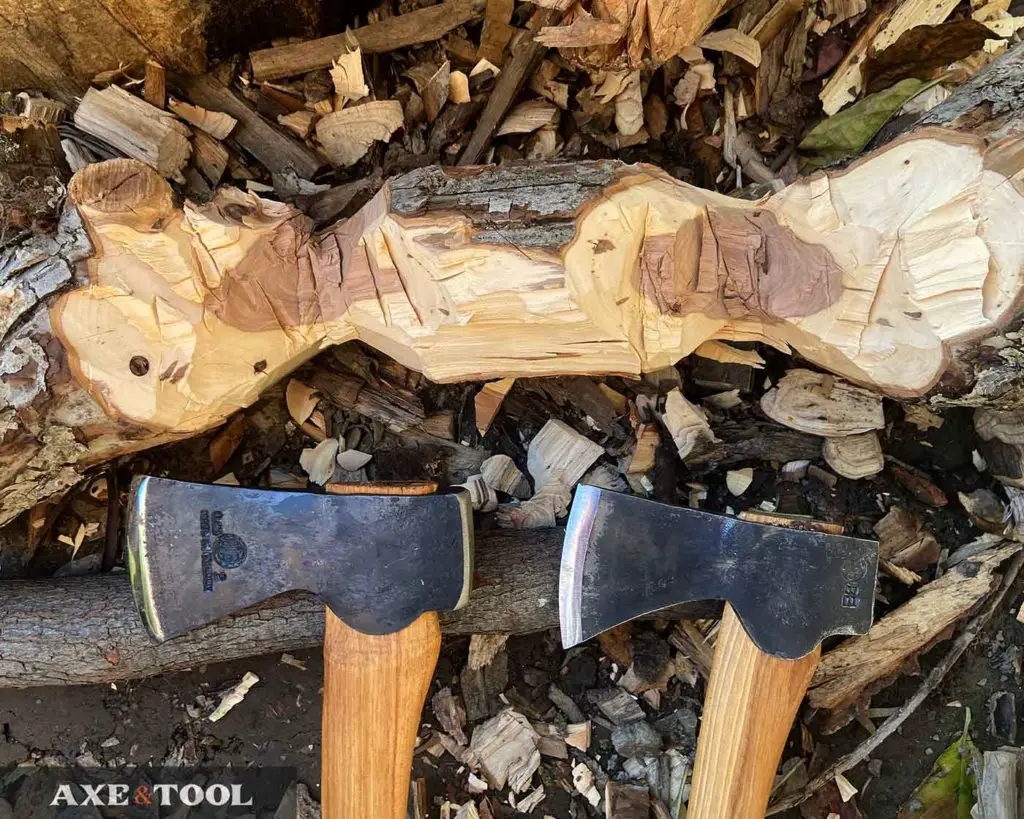
Interestingly I would say these axes are about even in chopping ability, which surprised me given the difference in weight and size. Both axes had decent penetration and popped out chips fine without getting stuck. But while they are sharp, the 30° bevel doesn’t drive as deep as a true aggressively ground chopping edge.
The Aneby/Ekelund handles more like a “normal” axe. Very capable, with a little less speed or power needed behind each swing. The toe is flared a little more so you need to be a little more careful when bucking and chopping near the ground, but I didn’t find it to be an issue.
The Small Forest Axe produced very similar chopping results. While it’s lighter, it also feels much “whippier” in hand. So I found I naturally was swinging it faster without much thought or effort.
The top of the head is flatter which is a bit better for avoiding the dirt when bucking or chopping low down.
Technically the Hults Bruk is going to be capable of a little heavier-duty chopping if needed, but given the likely tasks of these axes I think they score about even.
The Aneby/Ekelund splits better than the Small Forest Axe
Over the year I tried splitting a mix of fresh-cut greenwood logs and seasoned firewood. These are not designed as splitting axes, but they should be able to perform for smaller pieces.
The Aneby/Ekelund is a better splitter than the small forest axe – mostly because of the extra head weight. But there are a few aspects of the design that help as well.

First, the head of the Aneby has extra shaping in the cheeks, back towards the eye. It’s subtle, but it fills out a little in the middle which helps to separate and pry wood apart.
Second, the Hults design makes it easier to naturally avoid overstrikes. Overstrikes (hitting the handle on the wood) can lead to damaged and even broken handles.
The blade on the Gransfors design drops down quite far below the finger notch. This is great for fine control but means you have to be careful splitting. You only want to use the top portion of the bit for splitting to avoid hitting or scraping your handle on the log.
The Hults design has a shallower notch, meaning there’s an extra 9mm(0.33″) of height above the finger notch. And that extra blade (and weight) can go deeper into the log, and help you keep your handle safe.
You can see below how much taller the Aneby is when lined up at the notch.
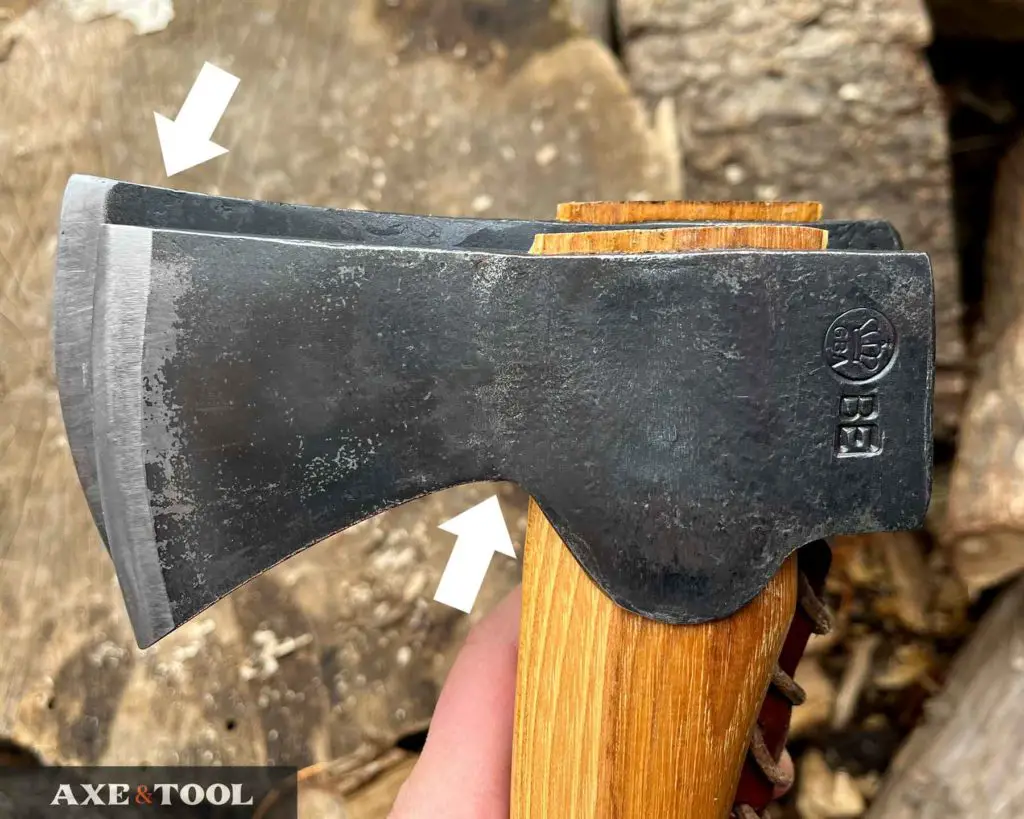
Both axes were able to split seasoned camp firewood, and 4-6 inch greenwood logs just fine. But the Aneby/Ekelund would typically take fewer strokes, and pop the wood apart more.
Carving with the small axes
This is a close one, and both axes are very capable of carving and detailed work in the field. But the Small Forest Axe is a better carver than the Aneby/Ekelund in my opinion.
The deeper notch on the Gransfors puts your hand higher behind the blade, improving control and reducing wrist motion. The shoulder of the handle is also smaller on the Gransfors, allowing you to have a better grip if you have choked up on the axe.
The lighter weight and shorter length of the blade (front to back) also make it easier to control, both when choked up on the handle or while holding mid-handle.
The heavier head of the Hults Bruk does offer some advantages adding force to cuts (most carving axes have pretty heavy heads). But I feel it takes a little more practice to get the hang of it.
Conclusion
I love both of these axes, and you will be happy with either of them. They are both capable of all the same type of work, just with slightly different strengths within those shared uses.
The Small Forest axe is more portable, and lighter but still very capable. I would choose it for backwoods trips where I am on foot or portaging, carrying more weight and going further – but still want maximum capability just in case. (See on Amazon).
I will take the Aneby/Ekelund when I plan on doing more axe work – camp or shelter building, felling, splitting, or trail clearing. Typically not for the longer-distance adventures. (Aneby on Amazon USA)(Ekelund on Amazon)
Again, both will do it all – you just need to go with what speaks to you.
If I had to pick one – I would probably go with the Hults Bruk Aneby / Hultafors Ekelund. I tend to lean into the power side of the equation. Then if I really needed something light and compact, I might take a smaller hatchet. But I could go either way depending on the day.
Please comment below If I missed something or if you have any questions. I do my best to respond to everyone.
About the author:
About the author:
Jim Bell | Site Creator
I’m just a guy who likes axes. I got tired of only finding crap websites, so I set out to build a better one myself.
I’m also on Instagram: @axeandtool



What a wonderful website you have put together here! Canadian and no B.S. Love it, great unbiased information and useful content! Keep up the good work!
Ha, really appreciate it!
Absolutely phenomenal write up! Easily the most comprehensive and well-researched comparison of these two axes I’ve come across. Thanks for sharing 🙂
Appreciate the comment! Glad you found it useful.
Great review – Thanks and greetings from Europe/Austria!
Stay safe!
Glad it was useful – and thanks from Canada!